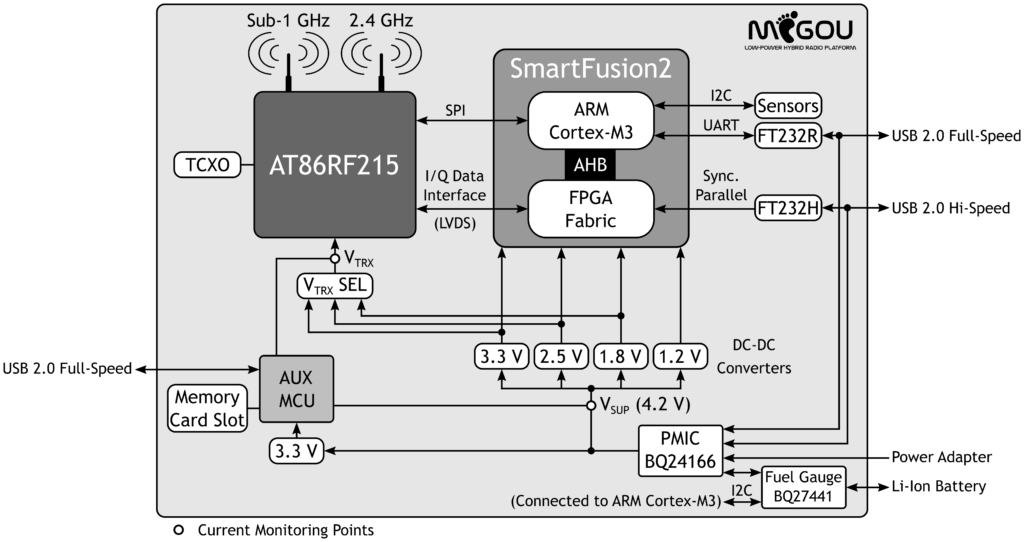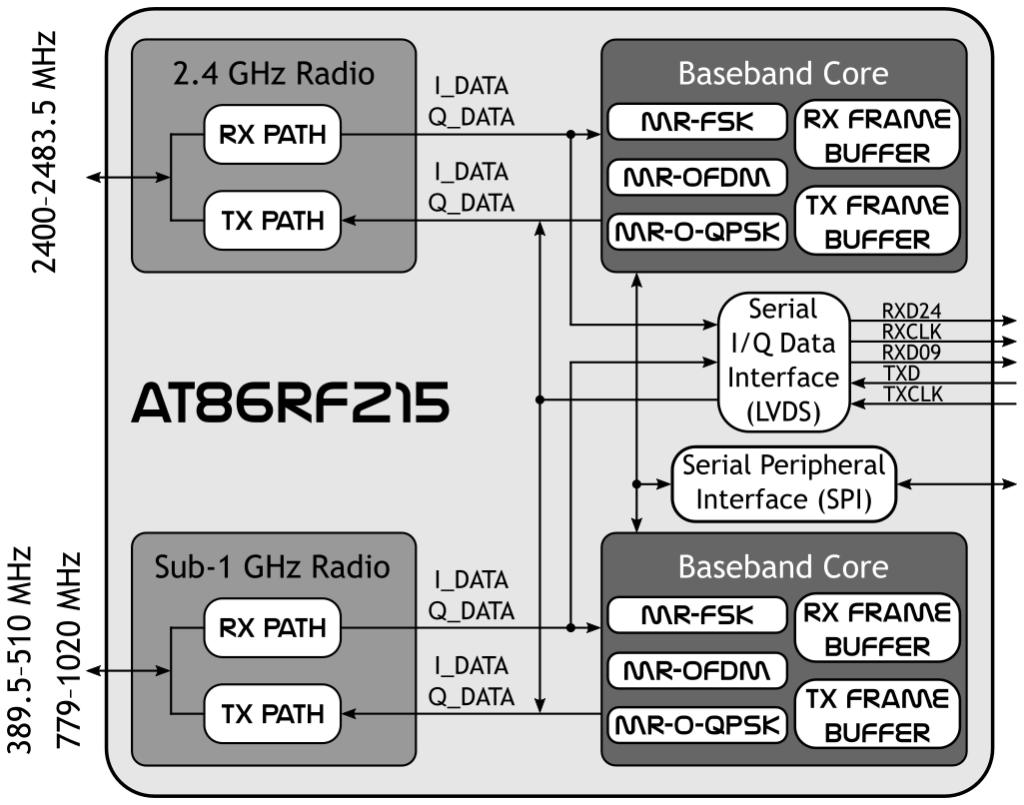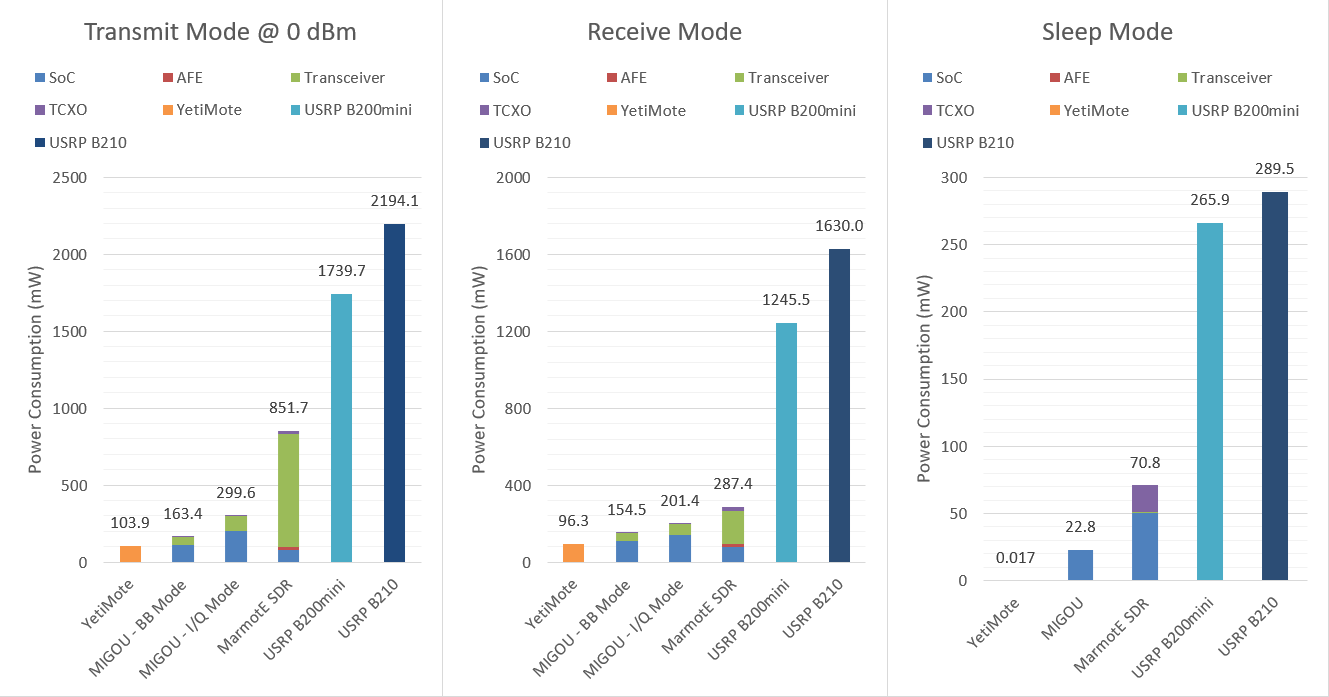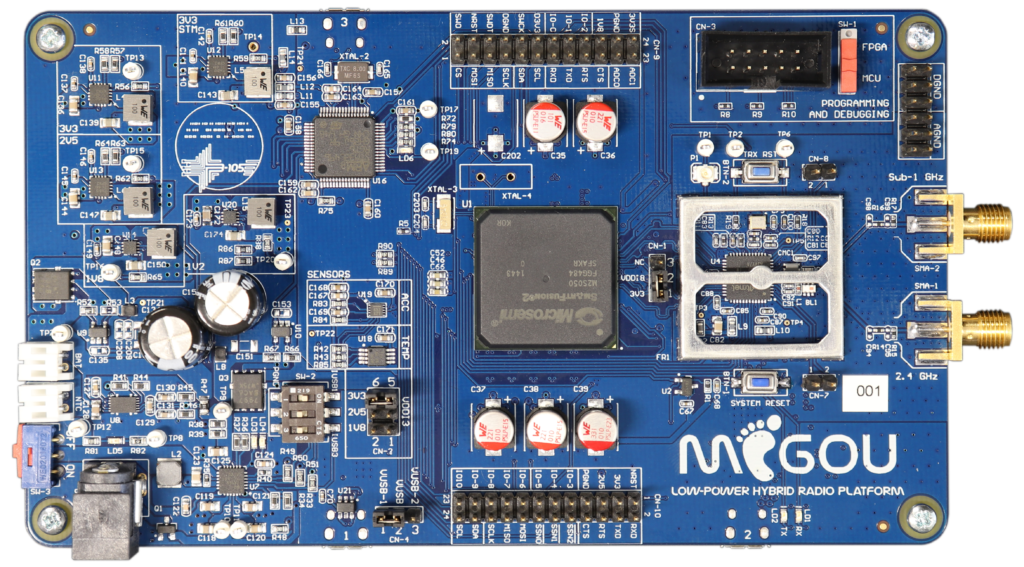Summary
MIGOU is a low-power wireless experimental platform designed to simultaneously address the energy-efficiency requirements of resource-constrained end-devices and the hardware flexibility demanded by the current Cognitive Radio (CR) and edge computing paradigms. This platform relies on the SmartFusion2 SoC that integrates an ARM Cortex-M3 processor and a flash-based FPGA, where high-speed processing tasks can be offloaded and computed more efficiently via hardware acceleration. In addition, at the radio level, the platform can operate both as a traditional node, which demands lower energy resources and development time, and as a Software-Defined Radio (SDR) system, which allows for the implementation of custom CR features. Moreover, the ability to dynamically switch between these two modes of operation opens the possibility for developing new hybrid strategies, taking advantage of both the flexibility offered by the SDR and the efficiency of the transceiver’s highly optimized baseband cores.
The power consumption of our platform was measured in transmit, receive, and sleep modes. These measurements were compared with the corresponding ones of other representative tools and systems: YetiMote, a traditional IoT end-device; MarmotE SDR, a low-power SDR system; and B200mini and B210 USRPs, two widely used high-performance SDR platforms. Moreover, all these devices were compared in terms of their hardware features. The results obtained confirmed that a state-of-the-art tradeoff between hardware flexibility and energy efficiency was achieved. These features will allow researchers to develop appropriate solutions to current end-devices’ challenges, and to test and evaluate them in real scenarios.
MIGOU Platform Sources
The schematics, the bill of materials, and the manufacturing files of the MIGOU platform are available HERE.
More about MIGOU
The increase in the number of mobile and Internet of Things (IoT) devices, along with the demands of new applications and services, represents an important challenge in terms of spectral coexistence. As a result, these devices are now expected to make an efficient and dynamic use of the spectrum, and to provide processed information instead of simple raw sensor measurements. These communication and processing requirements have direct implications on the architecture of the systems.
MIGOU is a wireless experimental platform designed to address these challenges from the perspective of resource-constrained devices, such as wireless sensor nodes or IoT end-devices. At the radio level, the platform can operate both as an SDR system and as a traditional highly integrated radio transceiver, which demands less node resources. For the processing tasks, it relies on a system-on-a-chip that integrates an ARM Cortex-M3 processor, and a flash-based FPGA fabric, where high-speed processing tasks can be offloaded. The hardware architecture of the platform is shown in Figure 1.

Atmel AT86RF215 was the component selected to provide the platform with hybrid radio capabilities. As shown in Figure 2, this device is comprised of two highly integrated radio transceivers, which operate in the sub-1 GHz and 2.4 GHz bands. Moreover, each of these transceivers supports two operating modes, which do not need to be the same. The ability to switch between these two modes of operation is what allows our platform to operate as a traditional node or as an SDR system.

On the one hand, in baseband (BB) mode, the AT86RF215 works as a COTS transceiver. In this configuration, the selected transceiver is internally paired with an optimized baseband core (BBC) that supports a wide variety of data rates with three modulation schemes. This allows for a highly efficient implementation of multiple PHY layers. In this mode, the BBC controls the radio and processes the data encoding/decoding for transmitting (TX) and receiving (RX) from the internal frame buffers. On the other hand, in the I/Q mode, the radio is controlled from an MCU via a serial peripheral interface (SPI) and the I/Q data stream is routed directly between the selected radio and a serial low voltage differential signal (LVDS) interface. This configuration allows for the use of a baseband processor for implementing custom SDR features. Specifically, as shown in Figure 3, when the platform is in I/Q mode, the ARM Cortex-M3 is responsible for setting and controlling the AT86RF215 via an SPI, and the I/Q samples are transferred through the LVDS interface between the selected radio and the FPGA, where they are processed. On the other hand, when the platform is in BB mode, the ARM Cortex-M3 controls the AT86RF215 via an SPI, and the FPGA can be put in Flash*Freeze mode if no other high-speed processing task is required.

In addition, a sleep mode is defined in which the AT86RF215 transceiver is set to deep sleep, where the TCXO is disabled; the FPGA is set to Flash*Freeze mode; the Cortex-M3 is halted and put in Waiting For Interrupt (WFI); and the necessary peripherals of the Microcontroller SubSystem (MSS) remain running at 1 MHz, which is the minimum standby clock frequency currently supported by Microsemi. The supply voltage of the transceiver is always 1.8 V. Table 1 shows a summary of the status of each of the main MIGOU subsystems in the different modes of operation.

The power consumption of the platform was measured in the different modes of operation. In addition, the hardware features and power measurements were compared with those of other representative platforms, which are shown in Table 2. The results obtained are shown in Table 3 and Figure 4.



These results confirm that a state-of-the-art tradeoff between hardware flexibility and energy efficiency has been achieved. These characteristics will allow for the development of appropriate solutions to current end-devices’ challenges and to test them in real scenarios.
Finally, to demonstrate MIGOU’s ability to operate as a hybrid radio system, an application that dynamically switches between its different modes of operation was developed. The sequence in which the modes change is based on a typical CR application in which a node wakes up from sleep mode, senses the spectrum (RX I/Q mode) to adapt its communication parameters to the environment, transmits the corresponding information (TX BB mode), and returns to sleep mode. Figure 5 shows the power consumption of MIGOU while running this application. In addition, the mode of operation in which the platform is at each moment is also shown at the top.

Authors
- Ramiro Utrilla – rutrilla-at-b105.upm.es
- Roberto Rodriguez-Zurrunero
- Jose Martin
- Alba Rozas
- Alvaro Araujo
Publications
For more details, please refer to the following publications:
R. Utrilla, R. Rodriguez-Zurrunero, J. Martin, A. Rozas, and A. Araujo, “MIGOU: A Low-Power Experimental Platform with Programmable Logic Resources and Software-Defined Radio Capabilities,” Sensors, vol. 19, iss. 22, 2019.
R. Utrilla, A. Rozas, J. Blesa, and A. Araujo, “A Hybrid Approach to Enhance Cognitive Wireless Sensor Networks with Energy-Efficient Software-Defined Radio Capabilities,” in 2017 International Conference on Embedded Wireless Systems and Networks (EWSN 2017), 2017, pp. 294-299.
Citing MIGOU
Please cite MIGOU in your publication if it helps your research work.
@Article{s19224983,
AUTHOR = {Utrilla, Ramiro and Rodriguez-Zurrunero, Roberto and Martin, Jose and Rozas, Alba and Araujo, Alvaro},
TITLE = {MIGOU: A Low-Power Experimental Platform with Programmable Logic Resources and Software-Defined Radio Capabilities},
JOURNAL = {Sensors},
VOLUME = {19},
YEAR = {2019},
NUMBER = {22},
ARTICLE-NUMBER = {4983},
URL = {https://www.mdpi.com/1424-8220/19/22/4983},
ISSN = {1424-8220},
DOI = {10.3390/s19224983}
}
License
This work is licensed under the Creative Commons Attribution 4.0 (CC BY) International License (http://creativecommons.org/licenses/by/4.0/).



